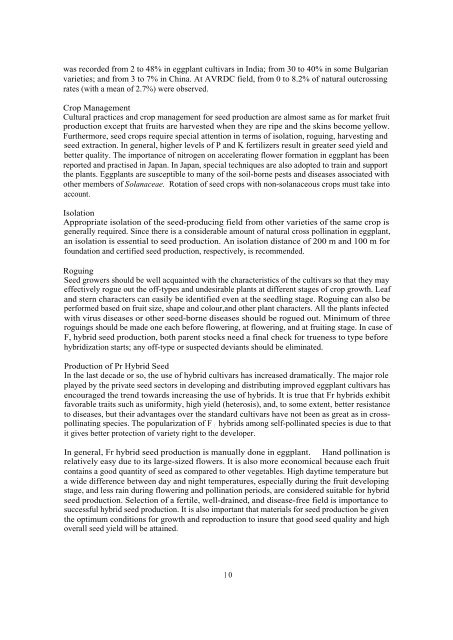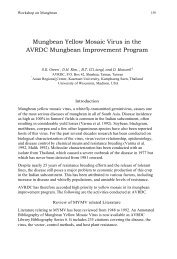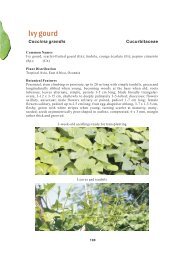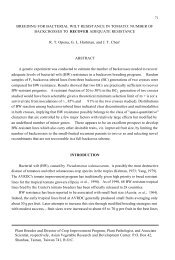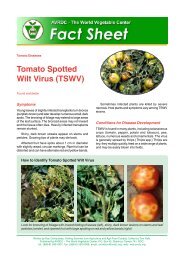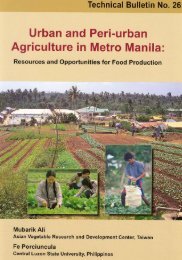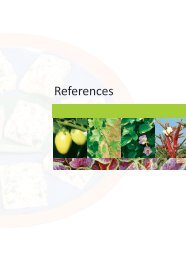CULTIVATION AND SEED PRODUCTION OF EGGPLANT NC Chen
CULTIVATION AND SEED PRODUCTION OF EGGPLANT NC Chen
CULTIVATION AND SEED PRODUCTION OF EGGPLANT NC Chen
You also want an ePaper? Increase the reach of your titles
YUMPU automatically turns print PDFs into web optimized ePapers that Google loves.
was recorded from 2 to 48% in eggplant cultivars in India; from 30 to 40% in some Bulgarian<br />
varieties; and from 3 to 7% in China. At AVRDC field, from 0 to 8.2% of natural outcrossing<br />
rates (with a mean of 2.7%) were observed.<br />
Crop Management<br />
Cultural practices and crop management for seed production are almost same as for market fruit<br />
production except that fruits are harvested when they are ripe and the skins become yellow.<br />
Furthermore, seed crops require special attention in terms of isolation, roguing, harvesting and<br />
seed extraction. In general, higher levels of P and K fertilizers result in greater seed yield and<br />
better quality. The importance of nitrogen on accelerating flower formation in eggplant has been<br />
reported and practised in Japan. In Japan, special techniques are also adopted to train and support<br />
the plants. Eggplants are susceptible to many of the soil-borne pests and diseases associated with<br />
other members of Solanaceae. Rotation of seed crops with non-solanaceous crops must take into<br />
account.<br />
Isolation<br />
Appropriate isolation of the seed-producing field from other varieties of the same crop is<br />
generally required. Since there is a considerable amount of natural cross pollination in eggplant,<br />
an isolation is essential to seed production. An isolation distance of 200 m and 100 m for<br />
foundation and certified seed production, respectively, is recommended.<br />
Roguing<br />
Seed growers should be well acquainted with the characteristics of the cultivars so that they may<br />
effectively rogue out the off-types and undesirable plants at different stages of crop growth. Leaf<br />
and stern characters can easily be identified even at the seedling stage. Roguing can also be<br />
performed based on fruit size, shape and colour,and other plant characters. All the plants infected<br />
with virus diseases or other seed-borne diseases should be rogued out. Minimum of three<br />
roguings should be made one each before flowering, at flowering, and at fruiting stage. In case of<br />
F, hybrid seed production, both parent stocks need a final check for trueness to type before<br />
hybridization starts; any off-type or suspected deviants should be eliminated.<br />
Production of Pr Hybrid Seed<br />
In the last decade or so, the use of hybrid cultivars has increased dramatically. The major role<br />
played by the private seed sectors in developing and distributing improved eggplant cultivars has<br />
encouraged the trend towards increasing the use of hybrids. It is true that Fr hybrids exhibit<br />
favorable traits such as uniformity, high yield (heterosis), and, to some extent, better resistance<br />
to diseases, but their advantages over the standard cultivars have not been as great as in crosspollinating<br />
species. The popularization of F 1 hybrids among self-pollinated species is due to that<br />
it gives better protection of variety right to the developer.<br />
In general, Fr hybrid seed production is manually done in eggplant. Hand pollination is<br />
relatively easy due to its large-sized flowers. It is also more economical because each fruit<br />
contains a good quantity of seed as compared to other vegetables. High daytime temperature but<br />
a wide difference between day and night temperatures, especially during the fruit developing<br />
stage, and less rain during flowering and pollination periods, are considered suitable for hybrid<br />
seed production. Selection of a fertile, well-drained, and disease-free field is importance to<br />
successful hybrid seed production. It is also important that materials for seed production be given<br />
the optimum conditions for growth and reproduction to insure that good seed quality and high<br />
overall seed yield will be attained.<br />
1 0


